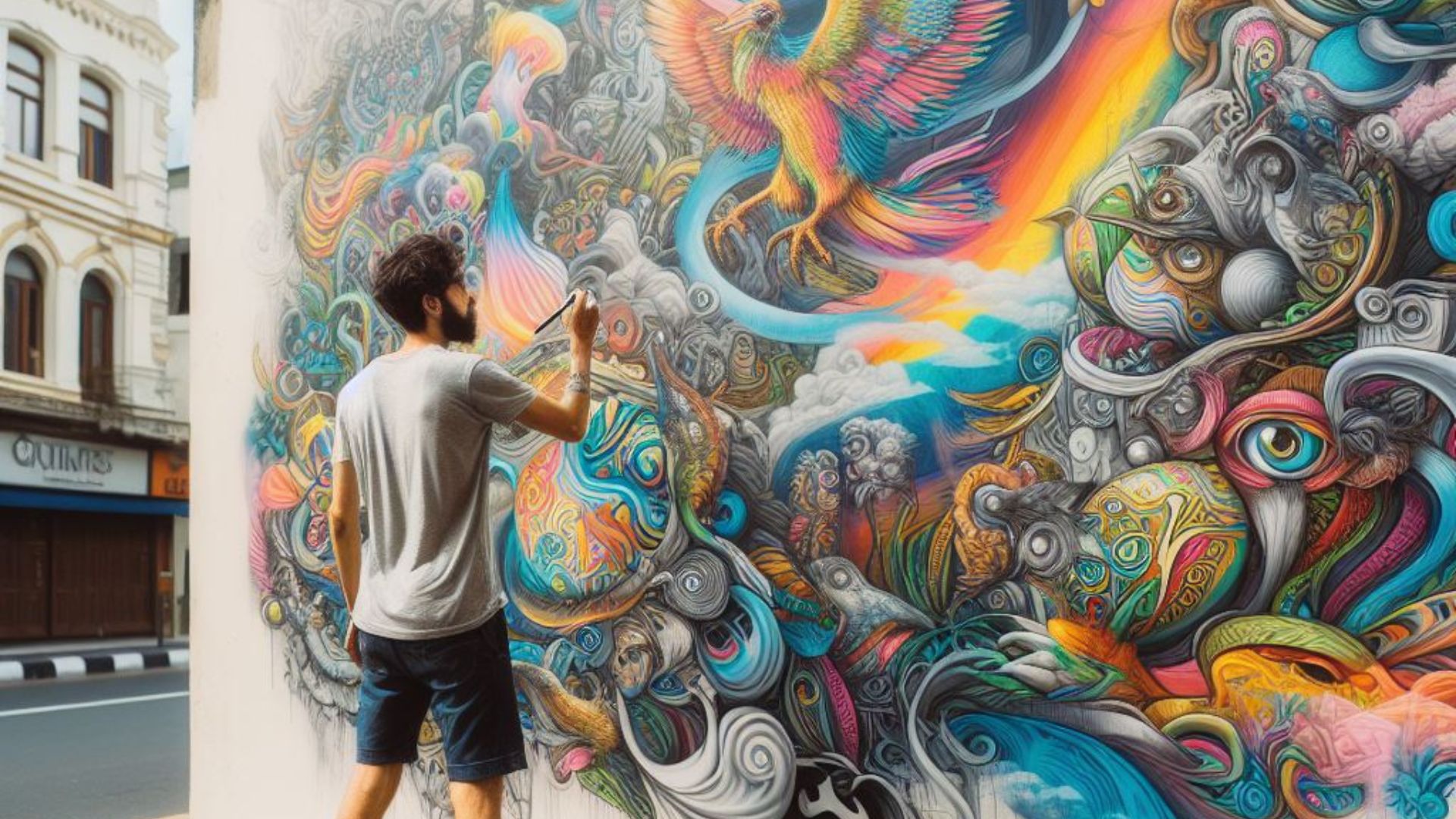Creating an outdoor mural is an exciting project that adds vibrancy and personality to a space. Whether you’re an experienced artist or diving into your first mural, understanding the ideal weather conditions is crucial for a successful and long-lasting artwork.
Why Weather Matters
The weather plays a pivotal role in outdoor mural painting. The conditions during the painting process and afterward can significantly impact the quality and durability of the artwork. Here’s a breakdown of the ideal weather conditions for painting an outdoor mural:
1. Temperature
Optimal Range: Ideally, aim for temperatures between 50°F to 85°F (10°C to 30°C) for painting murals. Extreme heat or cold can affect the paint’s consistency and drying time, leading to potential cracking or uneven application.
Impact of High Temperatures: High temperatures can cause the paint to dry too quickly, making it challenging to blend colors or apply multiple layers effectively. It may also result in premature drying before the paint bonds properly with the surface.
Impact of Low Temperatures: Cold weather can slow down the drying process, prolonging the time it takes for the paint to adhere to the surface. Additionally, freezing temperatures can affect the quality of the paint and cause it to lose its effectiveness.
2. Humidity
Ideal Level: Aim for moderate humidity levels, ideally between 40% to 70%. Excessive humidity can prevent the paint from drying properly, leading to potential issues like drips, splotches, or mold growth. On the other hand, extremely low humidity can cause the paint to dry too quickly.

3. Wind Conditions
Moderate Winds: Painting in windy conditions can be challenging as it may cause dust, debris, or other particles to stick to the wet paint, affecting the finish. Additionally, strong winds can make it difficult to control the paint application.
4. Precipitation
Dry Conditions: It’s crucial to avoid painting during rainy or damp weather. Moisture on the surface can prevent the paint from adhering correctly, leading to peeling or flaking in the long run.
Preparing for Painting
Before starting the mural project, consider these additional tips:
- Surface Preparation: Ensure the surface is clean, dry, and free from any contaminants that could affect the paint’s adhesion.
- Quality Paints: Invest in high-quality, weather-resistant paints specifically designed for outdoor use to ensure longevity.
- Testing: Perform a small test patch to observe how the paint reacts to the surface and weather conditions.
So,…
Painting an outdoor mural is an exciting endeavor that allows you to showcase your creativity. However, paying attention to weather conditions is vital for a successful and enduring artwork. choosing the right time and weather conditions, you can ensure that your outdoor mural stands the test of time, delighting viewers for years to come.
External Resources:
- Choosing the Right Paint for Outdoor Murals – ArtNews
- Tips for Outdoor Mural Painting – Mural Arts Philadelphia
- Weather and Painting Outdoors – Jackson’s Art Supplies
Remember, while these guidelines are helpful, it’s always a good practice to adapt based on your specific environment and mural project.
Tips for Painting Success
Now that we’ve covered the ideal weather conditions for outdoor mural painting, let’s dive deeper into some additional tips to ensure your painting process goes smoothly:
1. Time of Day
Choose the time of day wisely. Painting in the early morning or late afternoon can be advantageous as temperatures are usually milder, reducing the impact of harsh sunlight and extreme heat.
2. Shade and Shelter
If possible, work in shaded areas or create temporary shelters to protect the mural from direct sunlight, especially during the painting process. This can prevent the paint from drying too quickly and allow you more time to work on details.
3. Proper Ventilation
While wind can be challenging, ensuring proper ventilation is crucial. Working in well-ventilated areas helps paint fumes dissipate and prevents the accumulation of strong odors.
4. Layering and Drying Time
Allow sufficient drying time between layers. Patience is key when creating an outdoor mural. Rushing the process can lead to paint blending issues or uneven surfaces.
5. Weather Forecast
Stay updated on weather forecasts. Unexpected changes in weather conditions can impact your painting schedule. Be prepared to pause your work if unfavorable weather approaches.
6. Protective Coatings
Consider applying a protective coating once the mural is complete. Sealants or clear coats designed for outdoor use can provide additional protection against UV rays, weather elements, and vandalism.
7. Maintenance
Regular maintenance is essential for preserving the mural’s appearance. Periodic inspections and touch-ups can prevent minor issues from escalating and ensure the artwork remains vibrant over time.
Conclusion
Painting an outdoor mural is a rewarding experience that allows you to leave a lasting mark in public spaces. By adhering to ideal weather conditions, following best practices, and taking necessary precautions, you can create a captivating masterpiece that withstands the test of time. Each mural project is unique, so adapt these tips based on your specific environment and artistic vision. Embrace the journey, enjoy the creative process, and let your imagination transform spaces into captivating works of art!
External Resources:
- Choosing the Right Paint for Outdoor Murals – ArtNews
- Tips for Outdoor Mural Painting – Mural Arts Philadelphia
- Weather and Painting Outdoors – Jackson’s Art Supplies
Comparison tabular on this
Here’s a tabular comparison summarizing the ideal weather conditions for painting an outdoor mural:
| Weather Condition | Ideal Range | Impact on Painting |
|---|---|---|
| Temperature | 50°F to 85°F (10°C to 30°C) | – Extreme heat: Quick drying, challenging blending.
– Extreme cold: Slow drying, potential paint quality issues. |
| Humidity | 40% to 70% | – High humidity: Paint may not dry properly, leading to drips or splotches.
– Low humidity: Paint may dry too quickly. |
| Wind | Moderate | – Strong winds: Difficulty controlling paint application, debris on wet paint. |
| Precipitation | Dry conditions | – Moisture on surface: Paint won’t adhere properly, leading to flaking. |
Additional Tips:
| Consideration | Guidelines |
|---|---|
| Time of Day | Early morning or late afternoon for milder temperatures. |
| Shade and Shelter | Work in shaded areas, protect from direct sunlight. |
| Proper Ventilation | Ensure well-ventilated areas to disperse paint fumes. |
| Layering and Drying | Allow adequate drying time between layers. |
| Weather Forecast | Stay updated and be prepared for unexpected changes. |
| Protective Coatings | Apply sealants or clear coats for additional protection. |
| Maintenance | Regular inspections and touch-ups for longevity. |
These guidelines and considerations can serve as a helpful reference when planning and executing your outdoor mural project, ensuring a smooth painting process and a stunning, enduring artwork.
Wrapping up
As you embark on your outdoor mural painting journey, remember that while weather conditions play a significant role, your passion and creativity are the driving forces behind your masterpiece.
Stay attuned to the weather, prepare your materials, and choose the optimal conditions to bring your vision to life. Embrace the process, adapt to the environment, and enjoy every stroke of the brush as you transform ordinary spaces into captivating canvases of art.
By following these weather guidelines, incorporating best practices, and infusing your unique style, your outdoor mural will not only withstand the elements but also inspire and captivate all who behold it.
So, seize the opportunity, let your imagination soar, and paint the world with your creativity. Happy painting!

For over a decade, I’ve been Mike, an artist, crafter, and designer deeply immersed in the Croc world. I thrive on crafting unique, size-inclusive patterns, fostering creativity, and sharing them on ktforum.com. My designs aim to ignite your creative spark and delight you, ensuring clarity and ease of use through rigorous testing. Join me in expressing your creative flair and showcasing your craft with joy.
Related Posts
- The Best Time of Day for Painting an Outdoor Mural
When it comes to painting an outdoor mural, choosing the right time of day can…
- Painting a Mural on a Cinder Block Wall: Adding Artistry to Outdoor Spaces
Outdoor walls, especially those made of cinder blocks, offer a fantastic canvas for artistic expression.…
- Can you use acrylic paint for an outdoor mural
You can use acrylic paint for an outdoor mural! Acrylic paints are a fantastic choice…
- Choosing the Right Paintbrush for Mural Painting
Painting a mural is an exciting and expressive way to transform a space, but selecting…

